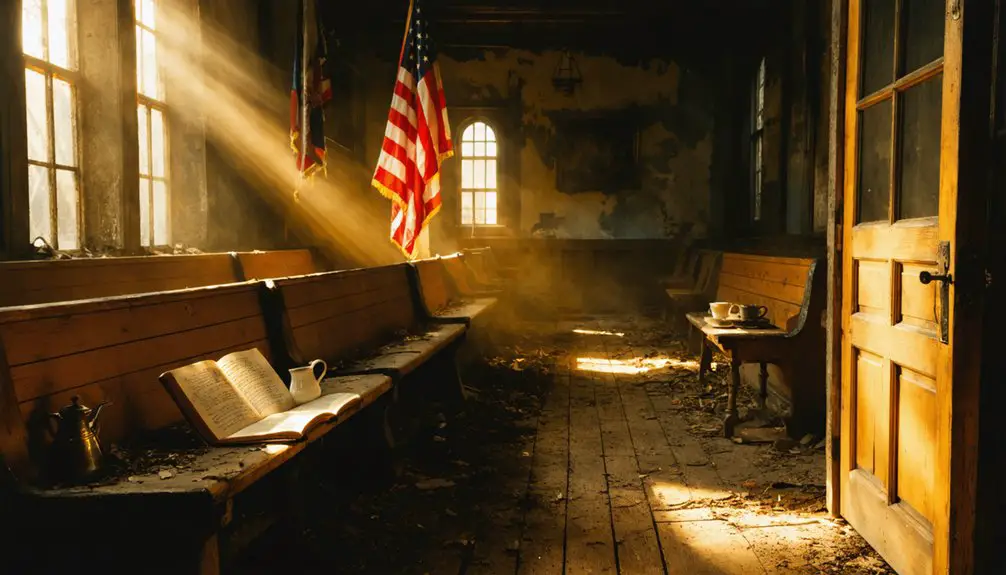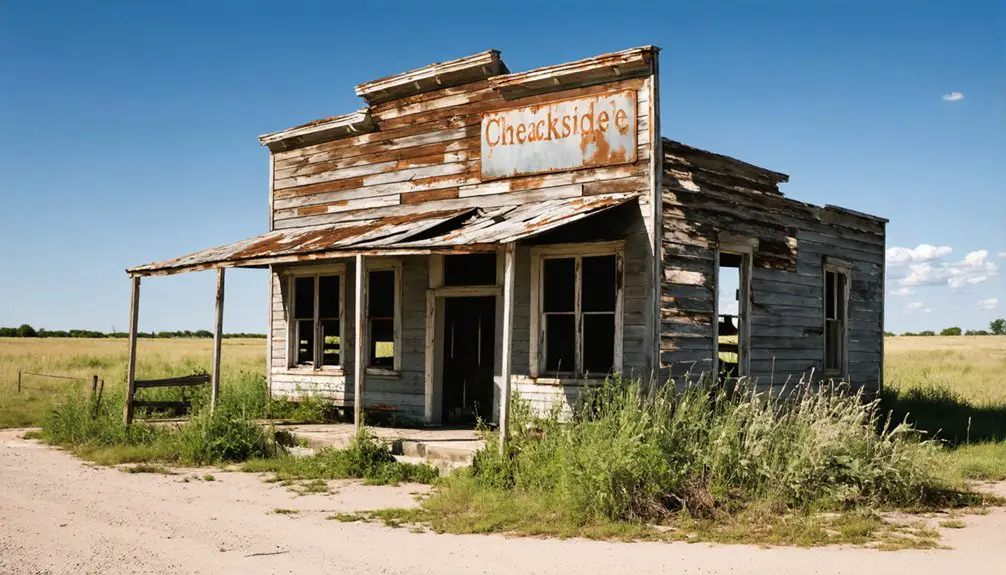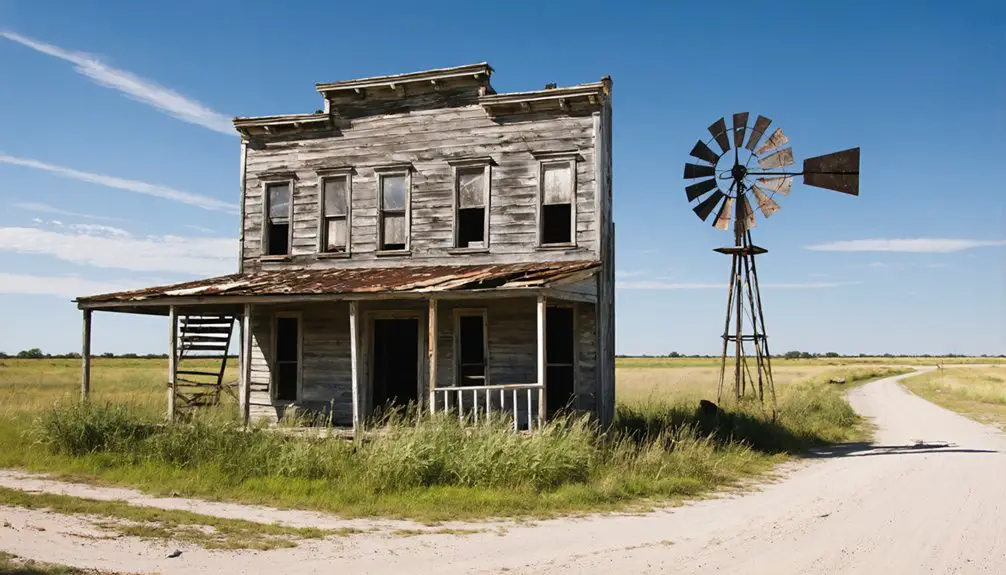You’ll find Cheapside’s remnants in Gonzales County, Texas, where Thomas Baker built the first log cabin in 1857. This former market town flourished in the late 1800s with three general stores, a cotton gin, and a gristmill, reaching its peak population of 500 in the 1930s. The Great Depression, depleted soil conditions, and World War II led to its decline. Today, a weathered church and community center stand as silent witnesses to a once-vibrant prairie settlement‘s fascinating story.
Key Takeaways
- Cheapside, Texas peaked at 500 residents in the 1930s before declining due to the Great Depression and falling cotton prices.
- Originally established in 1857, the town once featured three general stores, a drugstore, cotton gin, and gristmill.
- The Great Depression, depleted soil conditions, and World War II-era urban migration contributed to Cheapside’s abandonment.
- Today, only a community center and a weathered church remain as preserved structures from the town’s prosperous past.
- Natural reclamation has overtaken most of Cheapside’s original structures, with grasslands covering former building foundations.
The Birth of a Prairie Settlement
As the mid-nineteenth century unfolded across the Texas prairie, the first seeds of Cheapside’s settlement took root when Thomas Baker constructed his log cabin in 1857.
The settler stories that followed would shape this Texas community, as George Lord, fresh from the California Gold Rush, purchased 8,000 acres of rolling prairie. Just as in historic London where streets named Milk reflected the goods sold there, the early roads of Cheapside, Texas bore names that told tales of the settlement’s pioneer activities. The establishment of a post office in 1882 marked an important milestone in the town’s development. You’ll find that within a decade, families like the Prestons from Georgia joined Baker, creating a mosaic of Southern and English-descended settlers determined to tame the frontier.
Adventurous pioneers like George Lord carved out their dreams from Texas prairie, transforming wild grasslands into a patchwork of determined settlers.
The prairie challenges didn’t deter Dr. E. R. Henry, who named the settlement after his Virginia birthplace, or Thomas Carter, who’d later sketch the town’s layout with precise 90-foot lots.
Though Carter’s plat was lost to fire, these early pioneers established the foundation of what would become a thriving agricultural community.
From Market Square to Texas Plains
When you explore Cheapside’s origins, you’ll discover its name stems from medieval English marketplaces where merchants offered affordable goods to townsfolk.
As Texas’s frontier settlements expanded westward from established market squares like Houston’s, these traditional commerce centers shaped prairie communities through their familiar open-air trading formats and social gathering spaces. Just as Houston’s original town center served as a vital marketplace for early settlers in 1836, these trading posts became essential community hubs across Texas.
English doctor settlers established the town in 1857, bringing their homeland’s commercial traditions to the Texas frontier.
The ghostly remains of Cheapside’s marketplace, with its weathered foundations still visible among the plains grasses, stand as evidence to how English market traditions took root in nineteenth-century Texas soil.
English Roots Run Deep
The origins of Cheapside, Texas trace directly to its English namesake, Cheapside Street in London, though the name likely came indirectly through Cheapside, Virginia.
You’ll find English migration patterns deeply woven into the town’s history, with settlers like George Lord immigrating from England via Canada, and Dr. E.R. Henry bringing the name from Virginia. The cultural preservation of English heritage shaped the community’s development from its earliest days. The establishment of a Cumberland Presbyterian Church in 1874 further strengthened the community’s ties to its Protestant English roots.
- Thomas Carter’s town planning incorporated traditional English lot designs measuring 90 feet wide.
- English-style fraternal organizations, including Masonic and Woodmen lodges, established deep community bonds.
- The settlement pattern followed English-American frontier migration from established Eastern regions into Texas plains.
Commerce Shapes Prairie Life
Beyond its English heritage, Cheapside’s market square emerged as a vibrant commercial hub that defined prairie life in late 19th-century Texas.
You’d find three bustling general stores, a drugstore, and various shops serving the community’s needs, while the combined cotton gin and gristmill demonstrated agricultural sustainability through efficient processing.
The town’s economic resilience manifested in its diverse commercial offerings, from blacksmith services to entertainment venues, including two saloons.
A cozy one-room hotel and stable provided comfortable accommodations for travelers passing through the growing community.
By 1925, a small power plant signaled modernization, while social institutions like the Masonic lodge and weekend baseball games strengthened community bonds.
At its peak during the 1930s, Cheapside’s 500 residents enjoyed a self-sufficient prairie economy built on cotton farming, livestock raising, and robust local commerce.
Forgotten Marketplace Still Stands
Standing sentinel amid the Texas plains, Cheapside’s historic marketplace reveals traces of its vibrant past through architectural remnants and a relocated community church from 1897.
You’ll find marketplace nostalgia in the crumbling structures that once housed a thriving agricultural heritage, where cotton, livestock, and grain trading shaped prairie economics. What remains tells the story of a bustling crossroads that peaked at 500 residents during the 1930s.
- Original 90-foot-wide town lots still outline where merchants and farmers once gathered to trade their wares
- The preserved community church stands as a symbol of the social fabric that bound the marketplace community
- Weathered foundations of the former cotton gin, gristmill, and power plant mark the evolution of commerce
Glory Days of Rural Commerce
During its prime years between 1890 and 1930, Cheapside flourished as a bustling agricultural trade center, anchored by its thriving cotton economy and diverse commercial establishments.
You’d have found economic resilience in the town’s three grocery stores, drugstore, and various service businesses that catered to both residents and farmers. The 1889 construction of a combined cotton gin and gristmill demonstrated agricultural innovation that boosted local processing capabilities.
Cheapside’s economic backbone included diverse retail stores and modern agricultural facilities, serving both local residents and farming communities efficiently.
The town’s infrastructure supported this commercial significance, with a post office established in 1882 and early electrical power in 1925.
You could’ve witnessed the daily stagecoach arrivals, visited the blacksmith shop, or conducted business at one of two saloons. Professional services, including multiple doctors and a resident deputy sheriff, reinforced Cheapside’s role as a self-sustaining marketplace. The presence of Masonic and Woodmen lodges with their meeting halls added to the town’s commercial and social vitality.
Community Spirit and Social Life

While Cheapside’s commercial enterprises formed its economic backbone, the town’s vibrant social life created lasting bonds among its residents through diverse communal activities.
You’d find yourself immersed in regular community gatherings that shaped the town’s identity, from weekend baseball games to exciting rodeo events between matches. Former residents like Marge Kacir fondly recall the deep connections and mutual support that defined daily life in the community.
Social traditions flourished through the town’s various institutions, including the Cheapside Community Church and fraternal organizations like the Masonic and Woodmen lodges.
- Baseball teams and rodeos brought together up to 500 residents at the town’s peak, fostering a strong sense of local pride and entertainment
- The 1897-built church served as both a spiritual center and social hub, remaining as a symbol of the town’s communal spirit
- Multiple saloons, lodge halls, and a community center provided gathering spaces where residents forged lasting relationships through shared experiences
The Slow Fade of a Texas Town
As the Great Depression struck Cheapside in the 1930s, the town’s economic foundation began to crumble beneath the weight of plummeting cotton prices and depleted soil conditions.
You’d have witnessed the slow exodus that followed, as economic struggles forced families to seek opportunities elsewhere.
The population shifts became particularly pronounced during World War II, when younger residents left for urban jobs and returning soldiers chose city life over their rural roots.
What Remains Today: A Historical Legacy

Standing amid the quiet grasslands of South Central Texas, Cheapside’s remaining structures tell the poignant story of its historical legacy.
Like many semi-abandoned towns across Texas, Cheapside represents a familiar pattern of decline. You’ll find the most prominent architectural features in the weathered church, which stands as a symbol of the town’s historical significance. While most original buildings have succumbed to time, the 90-foot town lots laid out in 1880 still define the settlement’s footprint.
- The remnants of once-bustling establishments – broom factory, blacksmith shop, and cotton gin – hint at a thriving commercial past.
- A community center survives as one of the few maintained structures, preserving a fragment of local heritage.
- Natural reclamation continues as grasslands and wildlife embrace the crumbling foundations where stores and saloons once stood.
Today, you’ll experience a profound silence where this market town, named after a London street, once flourished.
Frequently Asked Questions
Are There Any Remaining Original Settler Descendants Still Living in Cheapside Today?
You won’t find settler descendants residing in Cheapside today, as family heritage records and settler genealogy show the town’s complete abandonment after economic decline forced residents toward urban opportunities elsewhere.
What Natural Disasters or Events Contributed to Cheapside’s Population Decline?
You won’t find flood damage or drought impact among Cheapside’s decline factors. Instead, economic challenges like falling cotton prices, soil degradation from over-farming, and post-WWII urbanization drove people away.
Can Visitors Legally Explore the Abandoned Buildings in Cheapside?
You can’t legally explore Cheapside’s abandoned buildings without explicit property owner permission. Since they’re on private land, entering without authorization constitutes criminal trespassing under Texas law.
Were There Any Notable Crimes or Conflicts in Cheapside’s History?
While crime often defines ghost towns’ histories, you’ll find Cheapside’s records show remarkably few conflicts or crimes. Beyond a deputy sheriff maintaining order, no significant criminal incidents were historically documented.
Does the Community Center Still Host Any Regular Events or Gatherings?
You won’t find any regular community activities at Cheapside’s community center today, as it’s no longer active. The ghost town’s local gatherings have ceased due to its virtually nonexistent population.
References
- https://en.wikipedia.org/wiki/Cheapside
- https://www.washingtontimes.com/news/2018/nov/12/some-recall-community-of-cheapside-now-a-ghost-tow/
- https://theforgottensouth.com/cheapside-texas-ghost-town-history/
- https://allacrosstexas.com/texas-ghost-town.php?city=Cheapside
- https://kqvt.com/texas-ghost-town/
- https://en.wikipedia.org/wiki/List_of_ghost_towns_in_Texas
- https://kqvt.com/texas-ghost-towns/
- https://www.amysatticss.com/ghost-towns/
- https://www.texasescapes.com/TOWNS/Texas_ghost_towns.htm
- https://urbexunderground.com/ghost-towns-in-texas/



